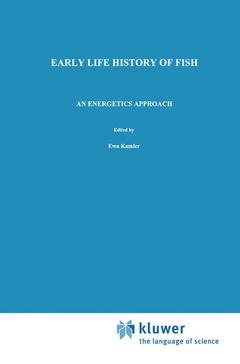Description
Early Life History of Fish, Softcover reprint of the original 1st ed. 1992
An energetics approach
Fish & Fisheries Series, Vol. 4
Author: Kamler E.
Language: English
Keywords
Publication date: 09-2012
267 p. · 15.5x23.5 cm · Paperback
267 p. · 15.5x23.5 cm · Paperback
Description
/li>Contents
/li>Comment
/li>
Among the fishes, a remarkably wide range of biological adaptations to diverse habitats has evolved. As well as living in the conventional habitats of lakes, ponds, rivers, rock pools and the open sea, fish have solved the problems of life in deserts, in the deep sea, in the cold Antarctic, and in warm waters of high alkalinity or of low oxygen. Along with these adaptations, we find the most impressive specializations of morphology, physiology and behaviour. For example we can marvel at the high-speed swimming of the marlins, sailfish and warm-blooded tunas, air breathing in catfish and lungfish, parental care in the mouth-brooding cichlids and viviparity in many sharks and toothcarps. Moreover, fish are ofconsiderable importance to the survival ofthe human species in the form of nutritious and delicious food of numerous kinds. Rational exploitation and management of our global stocks of fishes must rely upon a detailed and precise insight of their biology. The Chapman and Hall Fish and Fisheries Series aims to present timely volumes reviewing important aspects of fish biology. Most volumes will be of interest to research workers in biology, zoology, ecology and physiology, but an additional aim is for the books to be accessible to a wide spectrum ofnon specialist readers ranging from undergraduates and postgraduates to those with an interest in industrial and commercial aspects of fish and fisheries.
1 Introduction.- 2 Gonad formation.- 2.1 Seasonal changes of main constituents.- 2.2 Reproductive effort.- 3 Characteristics of fish reproductive products.- Energy content and composition of mature eggs.- 3.1 Egg size.- 3.2 Caloric value of egg dry matter.- 3.3 Egg composition.- 3.4 Methodological remarks.- 3.5 Concluding remarks.- Factors affecting fish offspring.- 3.6 Genetic factors.- 3.7 Nongenetic internal factors.- 3.8 Biotic external factors.- 3.9 Abiotic external factors.- 3.10 Effect of egg quality on fish offspring.- 4 Endogenous feeding period.- 4.1 Development.- 4.2 Yolk absorption.- 4.3 Body growth.- 4.4 Metabolism.- 4.5 Budgets of energy or matter.- 5 Mixed feeding period.- 5.1 General remarks.- 5.2 Critical periods in fish early life.- 6 Early exogenous feeding period.- 6.1 Development.- 6.2 Feeding.- 6.3 Body growth.- 6.4 Metabolism.- 6.5 Budgets of energy or matter.- 7 Feeding of fish larvae in aquaculture.- 7.1 Evaluation of effects.- 7.2 Live foods v. formulated diets.- References.- Species index.
'...this book is essential reading for marine ichthyologists! (The reviewer is certainly delighted to have a copy on his shelves.)...the book is full of useful information, it is quantitive, well written and well produced. It has an extensive bibliography, subject and species indexes, and a glossary. ...it should find a ready market with individual scientists as well as libraries.'Fisheries Research' ...it contains a wealth of information obtained from an impressive array of sources...very useful reference text for researchers and advanced students of fish development and culture of these early and critical stages in fish. I predict that it will become a well-used reference text for postgraduate students in Aquaculture...a very useful text...easy to read...a good investment.'Aquaculture
© 2024 LAVOISIER S.A.S.
These books may interest you

Fish Swimming 210.99 €



